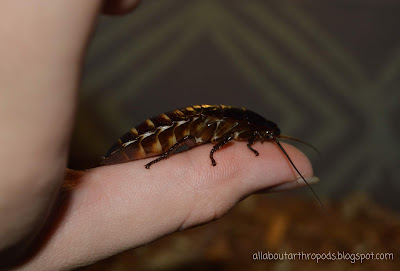Hello and welcome. 🙂
This post is about half story and half explanation. There will be a couple species that you never saw on my blog that you won't for a long time, possible ever, and a couple that you have saw that you may and may not see again. Although some notable arthropods have left my collection due to husbandry errors (which I will make a separate post about), that is not the case for any mentioned in this post. With that said, here we go. ⬇️
Right after we moved into our new house (just under two years ago), I was lucky enough to nab clean (non-hybrid) starter colonies of both Gromphadorhina grandidieri, the Tiger Hisser, and Gromphadorhina oblongonota, the Wide-Horn Hisser. Both were GORGEOUS species, particularly the grandidieri, although the group of oblongonota did contain some high-red individuals. The female Wide-Horns all reached a massive size, but only one or two males ever really grew to match the size of the
"old man". The Tigers were the only one of the two species to give birth for me, which I believe they did twice.
Now I've been allergic to roaches for a while now, particularly to hissers. Over time, I realized that the allergies were to the point where I wasn't even enjoying opening up their enclosures anymore. So after I confirmed that one of my best roacher friends was good with taking them off my hands, I knew the best decision was to send them off. Aaaand when I do things, I typically go all in, thus I figured I'd do away with my Elliptorhina laevigata as well. Unfortunately I didn't manage to get any pictures of the G.oblongonota before I sent them on their way, but I made sure to get some of the other species!
Elliptorhina laevigata
 |
| Adult male(s) |
 |
| Freshly-molted adult male |
 |
| Adult females |
 |
| Large nymph(s) |
Gromphadorhina grandidieri
 |
| Adult male |
 |
| Adult female(s) |
 |
| Large nymph |
 |
| Small nymphs |
 |
| Individuals attempting to hide |
Gromphadorhina grandidieri/Elliptorhina laevigata
 |
| Adult male comparison (G.grandidieri left, E.laevigata right) |
 |
| Adult male comparison (E.laevigata left, G.grandidieri right) |
Now onto the Vinegaroons. You guys all have to remember my beloved "Mastigoproctus giganteus" from posts of old. Well.....those may not have actually been M.giganteus. There was a revision of the genus last year that separated giganteus into seven total species, three of which are in the U.S, M.giganteus, M.tohono, and M.floridanus. If you'd like to learn more about that, you can read up on it
right here (thanks to
Invertebrate Dude for the link!). Anyways, this means that I really could have had any of those three species in my possession. In accordance with this revelation, I have changed all their post labels to a simple "Mastigoproctus sp.".
With that clarified, the reason they were included in this post is that they're sadly now only a memory. The female was the first to pass (right around January 1st of last year) and the male went nearly a year later. They were wild-caught adults, so who knows exactly how long they had been going before they were put into my hands. If you never got a chance to see them, you can do so
here and
here. Vinegaroons certainly provide a unique and pleasureful arthropod-keeping experience, so you can bet this won't be the last you'll be seeing of their kind on this blog. 🙂
I hope you all enjoyed this post and hopefully we can get to some more exciting subjects next time around! I'll see you right where I always do - next post!




































Goodbye hissers, and RIP Vinegaroons, sucks the female passed before making any babies, fingers crossed you have more luck the next time around!
ReplyDeleteThanks, man! I'm still not sure why she never had babies. Maybe the male was sterile or something because I mated them like twice I believe.
DeletePerhaps she was just too old, who knows... Vinegaroons are pretty tricky to breed, which is a shame because they are such neat invertebrates!
DeleteThat's a possibility as well. Indeed! I still think I like them better than any other predatory invert I've had besides mantids.
DeleteThey are very interesting looking and fun to watch eat, but mine was a bit of a pet hole TBH... Roaches will always be the most interesting invertebrates to me it seems... 😅
DeleteYou can never go wrong with roaches. lol BTW I still don't know how you get to use emojis in the comment section.
DeleteExactly LOL! 😂 My tablet has a special emoji section on the popup keyboard, that's how. 😉 😛 👍
DeleteU____U
DeleteI may not have money, but at least I have emojis, that's all a man needs nowadays...
DeleteAt least online. LOL
DeleteExactly LOL! 😂
Delete